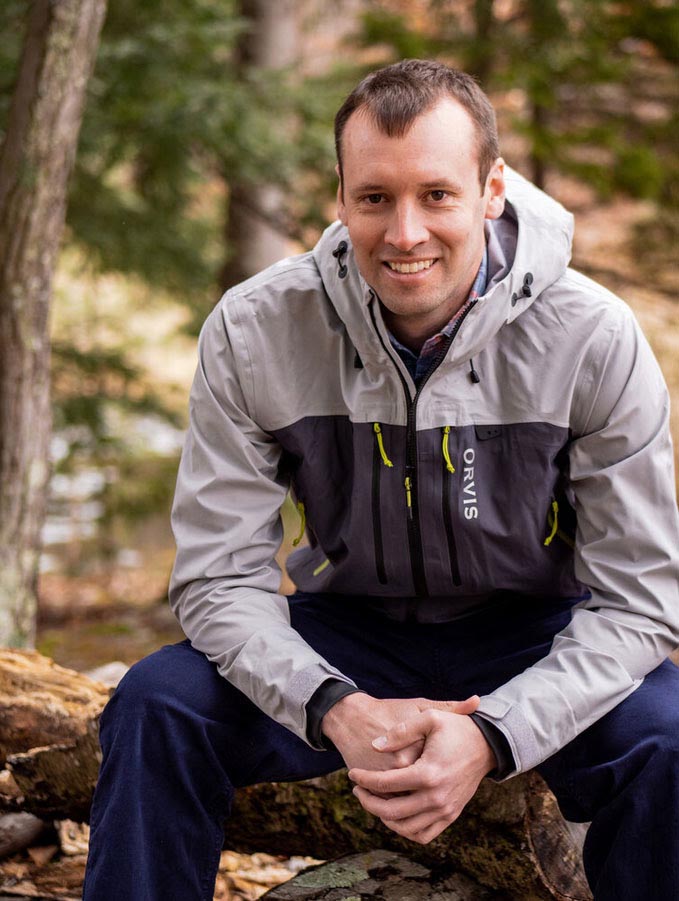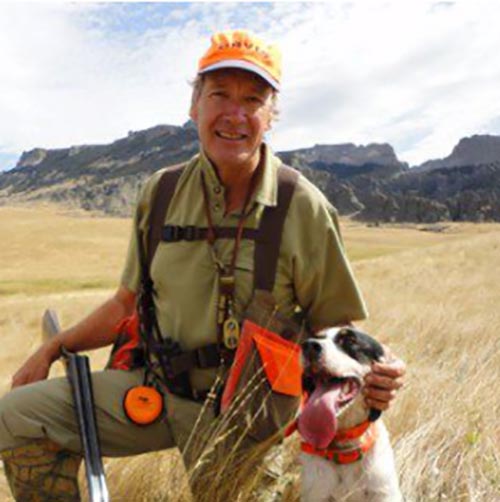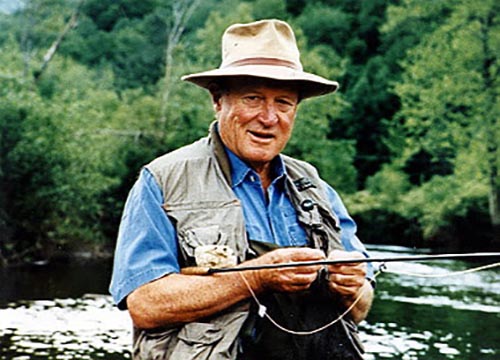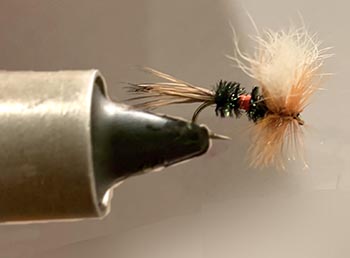 |
 |
The Orvis® Company
“More than half the intense enjoyment of fly-fishing is derived from the beautiful surroundings, the satisfaction felt from being in the open air, the new lease of life secured thereby, and the many, many pleasant recollections of all one has seen, heard, and done.” — Charles F. Orvis
For 165 years Orvis has been deeply committed to connecting people to the natural world. The Orvis Company, better known simply as Orvis, has been recognized by generations as synonymous with the sporting tradition. Since its founding in1856 by Charles Orvis in the small village of Manchester, Vermont, Orvis has grown from a tiny fly-fishing shop to the vast outdoor marketer it is today. Orvis's first product was hand-crafted wooden fly rods, and although fly-fishing remains at the core of Orvis business, it now boasts a complete line of both mens' and womens' clothing promoting adventure and wonder in nature, house and giftware, and recommendations of 'Orvis Endorsed' fishing and shooting lodges, outfitters and guides. From the beginning, the Orvis story has been one of innovation, determination and adaptability with an emphasis on customer service. While Charles Orvis was successful in making and selling his wooden fly rods, he recognized their limitations in their weight, length and performance so he set upon to develop a better rod. The result was the bamboo fly rod, made by gluing slender strips of seasoned bamboo into shafts which were attached to each other with a system of ferrules. By the late 1870s Orvis was producing and selling quality hand-crafted split bamboo rods to the fishing world. Charles also designed a novel fly reel which he patented in 1874 which became an immediate success, so much in fact, that it remains the basic design for Orvis's famed Battenkill Reel of today. Thanks to the innovations of Charles, Orvis was gaining popularity with the fishing community and was soon to receive even further acclaim when Charles's daughter, Mary Orvis Murbury, joined the company and concentrated on developing its fly-tying business. She opened a fly-tying room and employed a half-dozen ladies to tie flies. She then revolutionized the fly-tying industry by authoring and publishing two vividly illustrated books of fishing flies and giving each fly a distinctive name. The result was a universal consistency of each pattern, so a tier in Missouri tying a Royal Coachman would make the same fly as a tier in Manchester. Check for example below. Her books, and the quality of Mary's flies added greatly to the reputation of Orvis. After the death of Charles Orvis in 1915, the reins of the company were handed over to his sons, Robert and Albert. Unfortunately, they lacked their father's innovative and business skills and the company stagnated and floundered and came close to closing. But the name "Orvis" was still recognized in the sporting world as a symbol of quality. When word got out that Orvis was for sale a group of investors led by businessman Dudley ('Duckie') Corkran purchased the failing company from the bank for the modest sum of $4,500. Duckie immediately started the road to economic recovery by rebuilding the company's inventory and expanding its product line, even securing a government contract to make bamboo ski poles for use by the Army in WWll. He hired veteran rod-maker Wes Jordan, who sought out higher quality bamboo cane to use in constructing rods and developed a way to impregnate the rods with resins to make them more durable and give them a beautiful finish. He reintroduced new rod tapers and lengths, which made his rods easier to cast, more accurate, and more responsive. All this soon made Orvis bamboo rods a favorite with fishermen, a treasure to be handed down from generation to generation. When Duckie reluctantly decided in 1965 to retire and sell the company, he sought a purchaser who would carry on the Orvis tradition of providing quality products for the sporting world. No better a choice could have been made than that of Leigh Perkins, a savvy businessman who finally persuaded Duckie he was the right man. Under Leigh's stewardship Orvis was renamed The Orvis Company, and its product line vastly expanded to include womans' clothing, household and giftware, and travel accessories. The catalog expanded greatly to accommodate all the new offerings and an all-out blitz to grow the mail order business was undertaken. He established fly-fishing and wing-shooting schools which were immensely popular with folks wanting to learn the sports. In the 1980s Orvis began endorsing a select group of fly fishing and wing-shooting lodges, guides and outfitters that met Orvis's standards of quality. The designation "Orvis Endorsed" guaranteed to the sportsmen the same quality they had come to expect in the Orvis brand. Ownership passed in the 1990s to Leigh's son, Perk, who continued to expand the company. While Orvis always had always had an interest in conservation, going back to Charles Orvis's activism in cleaning and preserving his beloved Battenkill, Orvis increased it's commitment to natural resource conservation and stewardship by contributing 5% of pre-tax profits to worthy projects. Orvis is also strongly committed to the Casting For Recovery program, a breast cancer support group which has aided thousands of women stricken with the disease. Today, Orvis is led by Perk's son, Simon, who oversees a business that has grown to 1,700 employees and 80 retail locations. Despite its growth, Orvis continues to maintain its corporate headquarters in rural Vermont and maintain its tradition of providing quality goods and services for 165 years. www.orvis.com/experience-orvis The Perkins Family, Three Generations For Leigh Perkins, the importance of handing down family traditions—in life and in business—to the next generation was always on his mind. As his mother had done for him, Leigh passed on his passions to his children, who are all keen anglers, wingshooters, and conservationists. His sons—Leigh H. “Perk” Perkins, Jr. and David—made Orvis their lives’ work. When Leigh retired in 1992, Perk became president and CEO, with Dave working alongside him. Under their leadership, Orvis quadrupled in size. Today, the company is run by Perk’s son, Simon, while his brother, Charley, and his cousin, Hannah, also hold important positions in the business. SIMON PERKINS The Orvis Company announced its new president, Simon Perkins, in 2021...the third generation of the Perkins family to lead the company since 1965. Simon, 37, assumed full strategic and operational leadership of the company. He has served as the firm's chief operating officer since August 2018.  Simon started with the company in 2012 as commerce merchant for fly fishing and hunting, and later held leadership roles in merchandising, adventures and brand marketing. He replaced outgoing president and CEO Bill McLaughlin, who acted as an advisor through the transition period. Perkins' father is Leigh "Perk" Perkins, Orvis CEO from 1993 until 2018. The new president's grandfather, Leigh H. Perkins, purchased Orvis in 1965 and retired in 1992. "This company has meant so much to me throughout my life as I've watched it grow into the brand it is today," Simon Perkins said, "to inspire others to get outside, explore and connect with the outdoor wonders of the world. I look forward to working with our incredible team and partners to continue providing best in class products and service to our customers, and guiding the company and our community into the future." Before his time with Orvis, Simon Perkins spent nearly a dozen years as an upland hunting and fly fishing guide in Montana. Since joining the firm, he has championed projects aimed at diversifying the sport of fly fishing. Among his efforts are the "50/50 on the Water" initiative aimed at getting more women into fly fishing and the "Breaking Barriers Award," which highlights individuals working to break down barriers and introduce new audiences to the sport of fly fishing.Since joining the firm, he has championed projects aimed at diversifying the sport of fly fishing. Among his efforts are the "50/50 on the Water" initiative aimed at getting more women into fly fishing and the "Breaking Barriers Award," which highlights individuals working to break down barriers and introduce new audiences to the sport of fly fishing. Perkins serves on the advisory board of Trout Unlimited's Headwaters Youth Program and has been involved with Orvis' advocacy for various conservation projects. Perk Perkins · Orvis Company Owner & Board Member  Perk Perkins wearing a backpack in the mountains Perk is an avid outdoor enthusiast and pursues fly fishing, wingshooting, canoeing, XC skiing, bird watching, diving, sailing and hiking. He joined Orvis in the family business in 1977 and held positions in nearly all areas of the company until November 1992 when he was named CEO. He led the company as CEO from 1993 until 2018, growing the business from $88 million to $375 million. Perk’s legacy at Orvis was the development of a renowned business culture built around clear core values, particularly the family’s commitment to conservation driven by his mantra “If we are going to benefit from our natural resources, we must be willing to act to protect them.” He has walked his talk by committing time to numerous conservation boards such as The Nature Conservancy, World Wildlife Fund, Trout Unlimited, Greater Yellowstone Coalition and the Cornell Lab of Ornithology. In recent years his conservation focus has turned to regional watershed boards in the Northern Rockies including Clark Fork Coalition, Sun River Watershed Group, Snake River Fund, Protect our Waters – Jackson Hole. Dave Perkins - Orvis Company Owner & Board Member  Perk Perkins wearing a backpack in the mountains David is an avid angler and wingshooter and travels extensively in the pursuit of wild fish and birds with a dog or two by his side. He joined Orvis in the family business in 1979 holding numerous positions in the company from Fly Fishing Instructor to Rod and Tackle Lead to Orvis’ Executive Vice Chairman. David led the retail expansion and development of Orvis Adventures, Schools, Endorsed Lodges, Outfitters and Guides, culminating in a network of over 500 of the best guides and teachers to help anglers and wingshooters learn and grow in the pursuit of their passions. This work also led to Orvis expansion into international travel and the Sandanona Shooting Grounds. Like his father, Leigh, and brother, Perk, David is deeply committed to giving to back to protect fish and bird habitat, serving on the boards at the Ruffed Grouse Society, National Fish and Wildlife Foundation, Tall Timbers, the Theodore Roosevelt Conservation Partnership, Bonefish Tarpon Trust, and Wood River Land Trust. Leigh H. Perkins Sr. - Chairman Emeritus  Leigh H. Perkins fly-fishing in his fishing vest From fishing for bluegill as a child, to hunting in India, Morocco, and Scotland, Orvis Chairman Emeritus Leigh Perkins has dedicated his life to travel, outdoor pursuits and conservation. His passion extends well beyond participation as Leigh has been one of the outdoor life’s great ambassadors, sharing his passion with everyone within reach. Perkins combined his love of fishing, hunting and outdoor pursuits with a sharp mind for business when he purchased The Orvis Company in 1965, growing a small, highly respected business from $500,000 to nearly $100 million when he retired in 1992. Under Perkins’ guidance, The Orvis Company became a pioneer in the mail order industry and the destination for people the world over seeking inspiration, adventure and wonder in the natural world. Leigh introduced the Orvis Schools in his first years of owning the company, creating access and pathways for people to learn to fly fish. Understanding the importance and his responsibility to sustaining healthy habitat for hunting and angling pursuits, he was one of the first in the industry to give back, developing the 5% for Nature program and donating 5% of pre-tax profits to conservation organizations and efforts. While expanding the business, he remained focused and committed to his personal passion and Orvis’ roots in fly fishing and innovation in the sport. Leigh is also a successful author sharing his experiences and passion for the outdoors in A Sportsman’s Life and Rising Fish and Pointing Dogs, both receiving critical acclaim from the New York Times and the Wall Street Journal. Leigh remained Chairman Emeritus of the Board after stepping down from his position of president of the company and still managed to log nearly 300 days of hunting and fishing a year. He passed away on May 7, 2021 at the age of 93. One of his rules that will be forever remembered is "Always leave the campsite better than you found it."Orvis and the Royal Coachman Fly The Royal Coachman was first tied as a traditional winged wet fly and is a derivative of the Coachman wet fly. Mary Orvis Marbury in her Favorite Flies and Their Histories (1892) tells the story of its creation as follows:  Royal Coachman Fly Tied By Henry Wallace The Royal Coachman fly is a versatile and effective attractor pattern, tied in many forms attractive to trout, grayling, and steelhead. With an enduring history from England to modern day modifications made in the USA, this pattern should be in your fly box. The Fly was first made in 1878 by John Haily, a professional fly-dresser living in New York City. In writing of other matters, he inclosed [sic] a sample of this fly for us to see, saying: "A gentleman wanted me to tie some Coachmen for him to take up into the north woods, and to make them extra strong, so I have tied them with a little band of silk in the middle, to prevent the peacock bodies from fraying out. I have also added a tail of the barred feathers of the wood-duck, and I think it makes a very handsome fly." A few evenings later, a circle of us were together "disputing the fly question," one of the party claiming that numbers were "quite as suitable to designate the flies as so many nonsensical names." The others did not agree with him, but he said: "What can you do? Here is a fly intended to be a Coachman, yet it is not the true Coachman; it is quite unlike it, and what can you call it?" Mr. L. C. Orvis, brother of Mr. Charles Orvis, who was present, said: "Oh, that is easy enough; call it the Royal Coachman, it is so finely dressed!" And this name in time came to be known and used by all who are familiar with the fly. The Royal Coachman pattern is one of the very few patterns that appeared in Marbury's work that is still being tied and fished today in some form or another. © Copyright 2022 Preserve America |